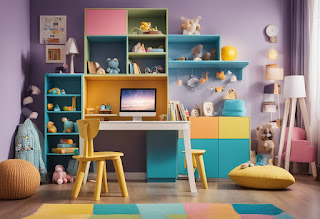Kids Furniture Plans for Fun and Functional Designs
The design and construction of children's furniture presents a unique set of challenges and opportunities. Functionality must be paramount, ensuring safety and ease of use for young occupants. However, the opportunity to integrate creativity and fun into the design process allows for the creation of pieces that are both practical and engaging, stimulating a child's imagination and fostering a positive relationship with their environment. This exploration delves into various aspects of designing and building kid-friendly furniture, considering safety, ergonomics, and aesthetic appeal.
Prioritizing Safety in Kids Furniture Design
Safety should be the cornerstone of any children's furniture plan. Young children are naturally curious and prone to accidents. Therefore, meticulous attention must be paid to potential hazards throughout the design and construction phases. Sharp edges, protruding hardware, and unstable structures pose significant risks.
Material Selection for Enhanced Safety
The choice of materials plays a crucial role in ensuring safety. Non-toxic finishes are essential to prevent ingestion of harmful chemicals. Water-based paints and stains are preferable to solvent-based options. Similarly, the use of durable, splinter-free woods like hardwood or engineered lumber minimizes the risk of injury. Avoid materials that readily chip or break, and thoroughly sand all surfaces to eliminate sharp edges and splinters.
Structural Integrity and Stability
Robust construction is paramount. All furniture pieces should be designed and built to withstand the rigors of active play. Sufficient weight capacity should be considered for beds, chairs, and tables. Stable bases are crucial to prevent tipping or collapse. Consider using robust joinery techniques such as mortise and tenon joints or strong dowel connections. For taller pieces, anchoring them to the wall can provide added stability and prevent potential tipping accidents.
Hardware Considerations
Hardware selection is a key aspect of safety. Avoid small, loose parts that could be easily detached and swallowed. Rounded edges on handles and knobs are preferable to sharp corners. Securely fasten all screws and bolts to prevent them from coming loose and becoming hazards. Where possible, consider concealed hardware to minimize the risk of injury.
Ergonomics and Child-Centric Design
Designing furniture specifically for children requires a thorough understanding of their physical characteristics and developmental needs. Ergonomics plays a crucial role in creating pieces that are comfortable, supportive, and conducive to healthy posture and growth.
Appropriate Sizing and Proportions
Furniture should be scaled appropriately for the child's age and size. Proper chair height and desk height are crucial for maintaining correct posture while seated. Beds should provide ample space for sleeping and movement without feeling overwhelming. Consider using adjustable furniture designs, allowing for growth and adaptation over time.
Comfort and Support
Comfort is vital, especially for items like chairs and beds. Well-padded seats and backrests provide support and alleviate pressure points. Consider the use of ergonomic materials like memory foam or high-density foam to enhance comfort. The furniture's overall design should be supportive of the child's posture and promote healthy physical development.
Accessibility and Ease of Use
Children's furniture should be easy to use and accessible. Drawers and storage compartments should have smooth mechanisms and be easily opened and closed by small hands. Handles and knobs should be positioned within easy reach. The design should promote independence and self-reliance.
Incorporating Fun and Creativity in Design
While safety and ergonomics are paramount, the opportunity to inject creativity and fun into the design should not be overlooked. Children's furniture should be engaging and stimulating, reflecting their personality and interests.
Thematic Designs
Designing furniture around specific themes can greatly enhance a child's engagement. A pirate-themed bed might incorporate a ship's wheel or treasure chest storage. A fairytale-inspired chair could feature whimsical carvings or painted decorations. The possibilities are limitless, allowing for personalized and imaginative designs.
Color and Pattern
The use of vibrant colors and playful patterns can transform a simple piece of furniture into a visually captivating element of a child's room. Consider using non-toxic paints and stains in a variety of colors to create a stimulating and engaging atmosphere. Incorporate patterns that resonate with the child's personality and interests.
Interactive Elements
Integrating interactive elements can further enhance the fun and engagement factor. A secret compartment in a desk can spark a child's imagination. A chalkboard painted onto a bedside table provides a space for creativity and expression. Consider adding playful details like hidden compartments or magnetic surfaces.
Building Your Own Kids Furniture: A Step-by-Step Guide
Constructing your own children's furniture offers several advantages, including cost savings and the ability to completely customize the design. However, it requires careful planning and execution to ensure safety and durability.
Planning and Design
Before starting construction, create detailed plans, including measurements, material lists, and cutting diagrams. Consider the child's age, size, and preferences when designing the furniture. Choose appropriate materials and joinery techniques to ensure structural integrity.
Material Preparation
Prepare all materials before starting construction. Cut lumber to the specified dimensions, sand all surfaces to remove sharp edges and splinters, and apply finishes according to manufacturer's instructions. Ensure all materials are non-toxic and appropriate for children's use.
Assembly and Construction
Follow the plans meticulously during assembly. Use appropriate tools and techniques to ensure strong and stable joints. Check for stability and alignment throughout the construction process. Prioritize safety and accuracy to prevent accidents and structural problems.
Finishing Touches
Once the construction is complete, apply any finishing touches, such as paint, varnish, or decals. Ensure all finishes are non-toxic and child-safe. Clean up any excess materials and debris. Inspect the finished piece carefully to ensure that all parts are securely fastened and no hazards exist.
In conclusion, designing and building children's furniture demands a balance of practicality, safety, and creativity. By prioritizing safety through careful material selection and robust construction, incorporating ergonomic principles for comfort and support, and integrating fun and engaging design elements, you can create furniture that is both functional and visually appealing, fostering a positive and stimulating environment for a child's growth and development.







0 comments:
Post a Comment